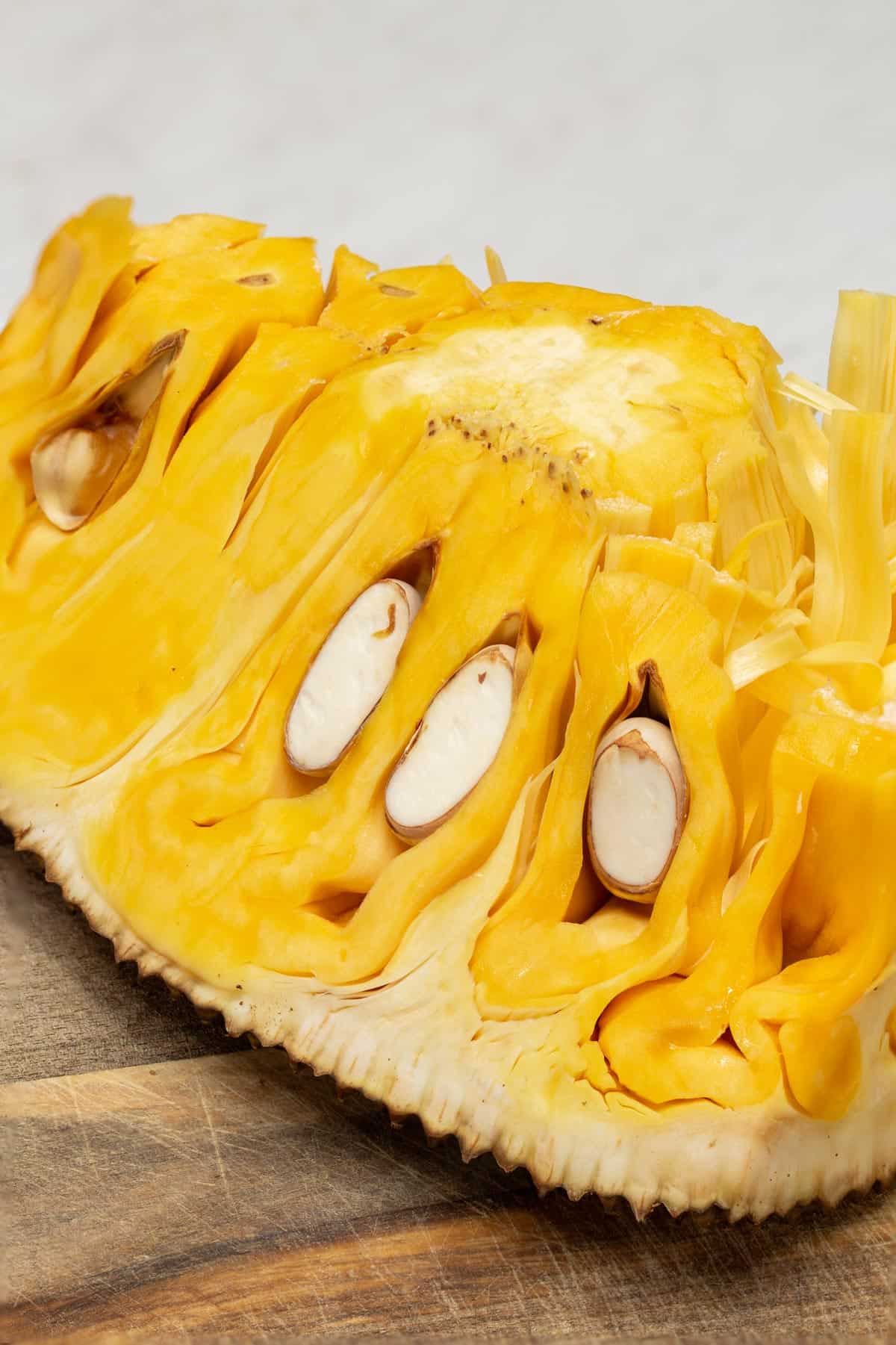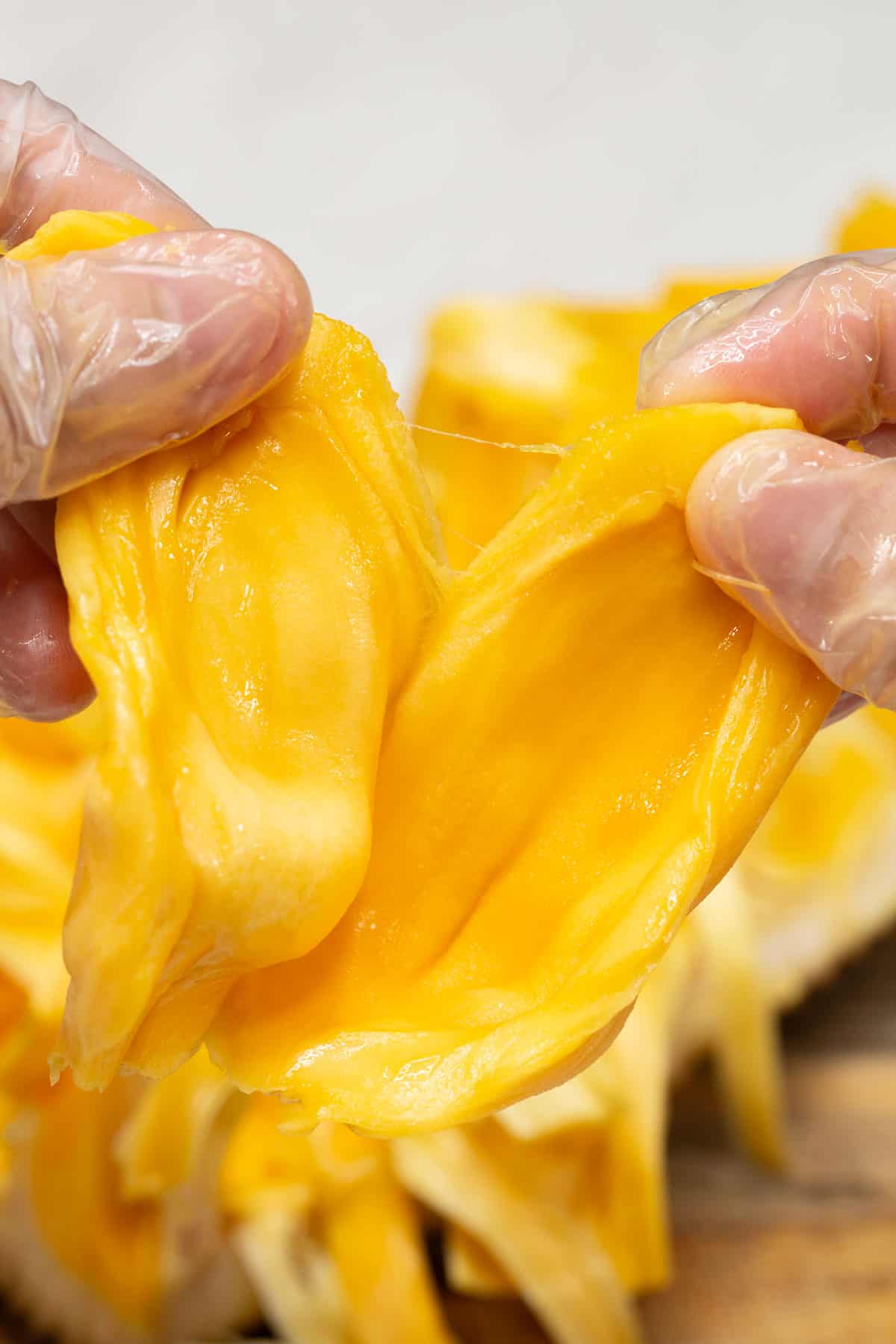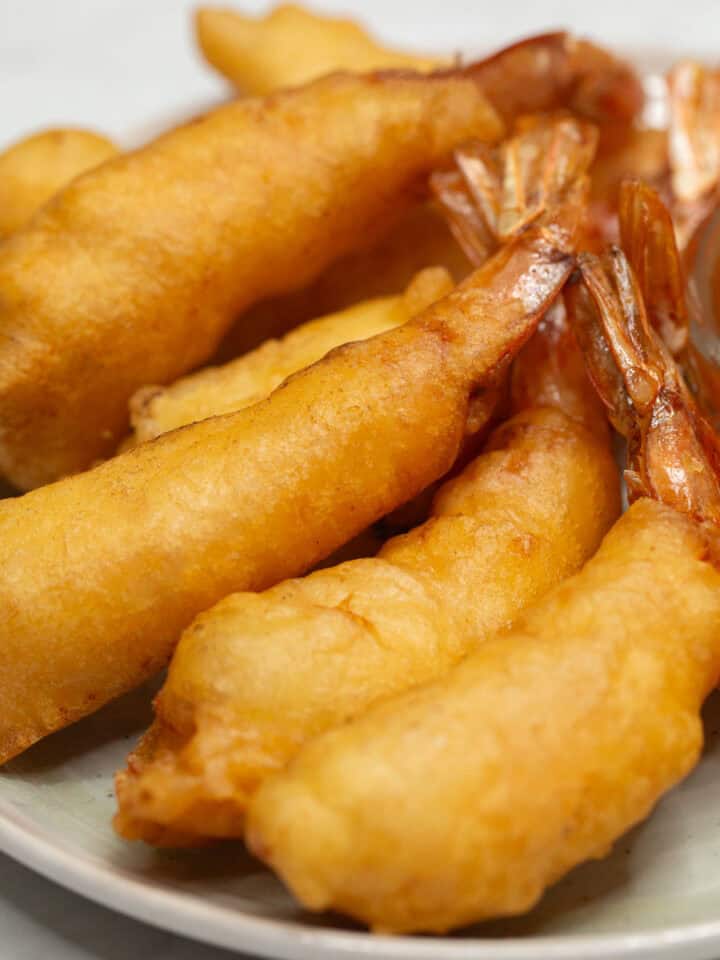Jackfruit, known as langka in the Philippines, is more than just another fruit. Its sweet taste is popular in desserts, and its unique texture makes it an excellent meat substitute.

Jump to:
What is jackfruit?
Jackfruit, scientifically known as Artocarpus heterophyllus, holds the distinction of producing the largest fruit of all trees. It belongs to the mulberry family (Moraceae) and is prized for its massive size and sweet, aromatic flavor.
The exterior is green and spiky, turning yellowish as it ripens. Its flesh is sweet and yellow. The young or unripe jackfruit has a mild taste and hearty meat-like texture.

What does jackfruit taste like?
Ripe jackfruit has a unique, sweet flavor with a wonderful aroma. Its taste is often described as a combination of ripe mango, banana, and pineapple with a hint of bubblegum sweetness.
When you open a jackfruit, you'll see golden-yellow pods, the edible portions of the fruit. The texture is soft, juicy, stringy, and somewhat rubbery. Each pod also houses a large, oval seed.

On the other hand, the unripe variety is firm and pale, almost whitish on the inside. It has a subtle, starchy taste that becomes tender when cooked.
While not sweet like its ripe counterpart, its meaty texture makes it a favored ingredient in savory dishes, especially as a plant-based meat substitute.

What are the health benefits of jackfruit?
According to Healthline, jackfruit is rich in nutrients, offering numerous health benefits:
- Antioxidants: Include Vitamin C for immune and skin health, carotenoids that reduce inflammation and risks of chronic diseases like type 2 diabetes and heart disease, and flavanones which aid in regulating blood sugar, blood pressure, and cholesterol.
- Potassium: Supports heart health and maintains stable blood pressure.
- Fiber: Promotes gut health and provides a feeling of fullness.
- Low Glycemic Index: Beneficial for controlling blood sugar by slowing digestion.
- Protein: Offers a notable amount compared to other fruits.
While jackfruit is safe for many, those with birch pollen allergies or diabetes should seek medical advice before regular intake. If new to jackfruit, start with a small amount to check for allergies. Always consider health concerns when adding new foods to your diet.

How to prepare and store jackfruit
Eating jackfruit can be an adventure, especially for those unfamiliar with its unique texture and taste. Here's your step-by-step guide to preparing and storing it:
Ripe jackfruit
- Prepare Your Workspace: Spread out a newspaper or plastic sheet to handle the sticky nature of jackfruit. Lightly oil your hands and knife to counteract the latex from the fruit, or use a pair of gloves.
- Cut the Fruit: Lay the jackfruit on its side, remove the stem, and slice it in half. For manageable portions, divide further into wedges. Remove the tough core running down the center.
- Remove the Arils or Pods: This is the fleshy part you eat raw. Use your oiled hands or a knife to detach these yellow pods from the fibrous white matrix. Each aril contains a seed; remove it and set aside.
- Enjoy the Flesh: The sweet, aromatic fruit can be eaten as is or added to desserts.
- Cook the Seeds: These are a delicacy in their own right. They can be boiled, roasted, or steamed to yield a treat reminiscent of chestnuts.
- Clean-Up: Combat the sticky latex with oil on your hands and knife. A thorough rinse with warm, soapy water will finalize the cleaning.
- Storage: Leftover jackfruit should go in the refrigerator and is best consumed within a few days. Freeze the arils to extend their shelf life.

Unripe jackfruit
- Set Up Your Workspace: Spread a newspaper or plastic sheet on your counter. Apply some oil to your hands and knife to ease the cutting process and help avoid the fruit's sticky latex, or use a pair of gloves.
- Peel the Fruit: Start by removing the stem. Peel off the green, prickly exterior with a sharp knife, revealing the pale, meaty interior.
- Section and Core: Slice the jackfruit into manageable sections, removing the tough core. While ripe jackfruit is consumed for its pods, the entire flesh of unripe jackfruit is used in dishes. Depending on your recipe, you can further slice them into smaller pieces. The seeds are usually left in and cut together with the flesh.
- Cook the Flesh: In Filipino recipes, these jackfruit segments are simmered until they achieve a tender consistency. Depending on your dish, they can be left in larger pieces or further pulled apart to resemble shredded meat—a popular use in vegetarian and vegan dishes.
- Clean-Up: Like its ripe counterpart, unripe jackfruit can be sticky. Use oil to ease off any residue on your hands and knife. A good scrub with warm, soapy water will do the trick.
- Storage: Any leftover unripe jackfruit pieces should be refrigerated and used within a few days. You can also freeze them raw or cooked to prolong their shelf life.

How to buy jackfruit
When buying jackfruit, your decision will depend on various factors, including availability, intended use, and preparation. Here's a guide to help you navigate your options:
- Availability and Location: Depending on where you are in the world, jackfruit might be readily available fresh at local markets or grocery stores. In tropical regions, for example, you might find them more commonly in their natural, fresh state.
- Ripe vs. Unripe: Both ripe and unripe jackfruit have their distinct uses. Ripe jackfruit has a strong sweet aroma, a yellowish skin, and yields slightly to gentle pressure. Unripe jackfruit has green skin, no noticeable aroma, and feels firm to the touch.
- Canned or Frozen Options: Peeling and preparing fresh jackfruit can be tricky because of its size and sticky latex. Many opt for canned or frozen jackfruit since it's often pre-cut and easier to handle. These choices are handy for those unfamiliar with prepping fresh jackfruit or for those who want to save on prep time.
- Fresh is Best, Sometimes: While canned or frozen jackfruit offers convenience, preparing and savoring fresh, locally-grown jackfruit provides a richer flavor and a fuller experience with the fruit.
- Check the Label: When choosing canned or frozen jackfruit, review the label to avoid added sugars or preservatives for a more natural taste.

Filipino recipes with jackfruit
Jackfruit is a popular fruit in the Philippines, loved both as a standalone treat when ripe and as a versatile ingredient in sweet and savory dishes. Here are some of our favorites:
- Ginataang Langka: This is a savory dish with unripe jackfruit simmered in coconut milk, seasoned with shrimp paste or fish sauce.
- Turon: Deep-fried saba bananas with ripe jackfruit rolled in lumpia wrappers.
- Halo-Halo: A shaved ice dessert with gulaman, nata de coco, corn, sago, Ube Halaya, and sweetened beans and fruits (jackfruit, macapuno, mangoes, or bananas). It is topped with crunchy pinipig , Ube or Mango Ice Cream, Leche Flan, and evaporated milk.
- Ginataang Bilo-Bilo: A dessert or snack made with glutinous rice flour shaped into small balls, then cooked in coconut milk with sugar and other ingredients like cassava, ube, saba bananas, jackfruit, and sago.
- Jackfruit Ice Cream: A creamy, frozen dessert made with ripe jackfruit, heavy cream, and condensed milk.
Other ingredient guides you may like

Did you like this post? I would love to know! Your feedback helps me make better recipes. Please rate, review, or comment below. Questions about this post are welcome, too!
Let's connect on Facebook, Instagram, Pinterest, TikTok, Twitter, and Youtube. Be sure to tag me when you try any of my recipes @recipesbynora!











Eve
Jackfruit is my favorite fruit. Fresh is the best but I settle for frozen ones because I’m too lazy and impatient to peel them. Lol
Nora Rey
totally get that! Peeling jackfruit can be a task, but the flavor is so worth it. Frozen is a great convenient option.😄🍈